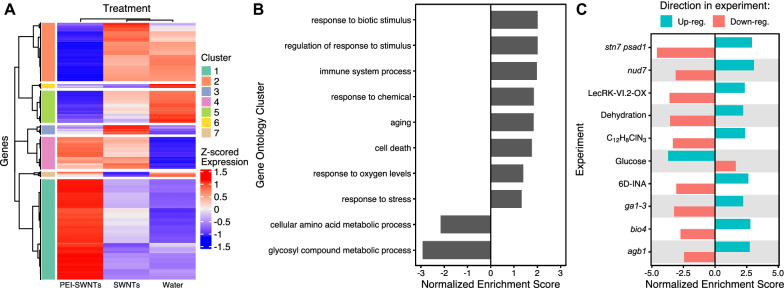Correction to: Journal of Nanobiotechnology (2021) 19:431 10.1186/s12951-021-01178-8
Following publication of the original article [1], the authors identified an error in Fig. 2. The correct Fig. 2 is given in this erratum.
Fig. 2.
PEI-SWNT responding genes are involved in stress responses, immune system, and programmed cell death. A Gene expression heatmap of genes with statistically significant twofold expression change in at least one of the three treatments, compared to non-infiltrated samples. Clusters 1 and 2 show PEI-SWNT specific up- and down-regulated genes. B, C Gene Set Enrichment Analysis of Cluster 1 and 2 genes using Biological Process Gene Ontology categories (B), and Arapath and PlantGSEA databases (C). Up- or down-regulation genes in the original experiment were used as independent gene sets to calculate their normalized enriched score. Details corresponding to each experiment can be found in Additional file 4: Table S4C
Footnotes
Publisher's Note
Springer Nature remains neutral with regard to jurisdictional claims in published maps and institutional affiliations.
Reference
- 1.Gonzalez-Grandio E, Demirer GS, Jackson CT, Yang D, Ebert S, Molawi K, Keller H, Landry MP. Carbon nanotube biocompatibility in plants is determined by their surface chemistry. J Nanobiotechnol. 2021;19:431. doi: 10.1186/s12951-021-01178-8. [DOI] [PMC free article] [PubMed] [Google Scholar]



